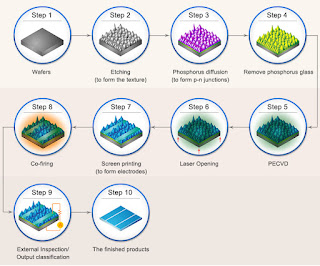Mounting your Solar Panels
First off, solar panels are large flat objects that may catch the wind and they are expensive - so they need to be securely fixed. Also, considering their value, you may want top make them difficult to remove!
Secondly, there may be regulations in your area determining how they should be mounted, particularly if on a house roof.
Thirdly, take care if working on a house roof. Someone once suggested that more people are likely to die falling off a roof while mounting solar panels, than are likely to be killed from radiation due to nuclear power.
Secondly, there may be regulations in your area determining how they should be mounted, particularly if on a house roof.
Thirdly, take care if working on a house roof. Someone once suggested that more people are likely to die falling off a roof while mounting solar panels, than are likely to be killed from radiation due to nuclear power.
Which Direction Should They Face
In most cases, if you are in the northern hemisphere they should face due south and if in the southern hemisphere, they should point due north.
You may need to vary this slightly if you cannot avoid a hill or high trees etc blocking the sun at one end of the day. If hill to the west results in you losing the evening sun early, then use your judgement to point your panels SLIGHTLY towards the east.
You may need to vary this slightly if you cannot avoid a hill or high trees etc blocking the sun at one end of the day. If hill to the west results in you losing the evening sun early, then use your judgement to point your panels SLIGHTLY towards the east.
I emphasise slightly as it must be remembered that the early morning sun will be of little value as it is so low in the sky.
The Angle to the Horizontal
The general advice here is that the angle of your panels relative to horizontal should be the same as you latitude in spring and autumn, 15 degrees less in summer, and 15 degrees more in winter.
If at all possible, it will be worth mounting your panels so that you can change their angle at least 4 times per year.
If you have to mount them so that they are fixed then go for the same angle as your latitude. You may however wish to vary this according to which part of the year is your need the greatest. For many people this will be winter time though if you have swimming pool and cooling fans for the summer,this may not be the case.
If at all possible, it will be worth mounting your panels so that you can change their angle at least 4 times per year.
If you have to mount them so that they are fixed then go for the same angle as your latitude. You may however wish to vary this according to which part of the year is your need the greatest. For many people this will be winter time though if you have swimming pool and cooling fans for the summer,this may not be the case.
Materials Used
Galvanised angle steel is usually appropriate. There is a slight possibility of corrosion occurring between aluminium (the normal material used for the frame of the panel itself) and the zinc used in the galvanising. However in most outdoor situations that are reasonably dry, this shouldn't be a problem.
Further Expansion
If possible, plan your method of mounting solar panels so that you can easily add an extra panel or two to the system. You may find, when you have experience of using your solar power system that you would benefit from extra capacity.
Trackers
Panels will be much more efficient at producing electricity if they are always facing the sun. Trackers are available that serve as the panel mounting and will point them towards the sun.
There are several types to choose from
Passive trackers use a system whereby a liquid moves as it is heated by the sun and is used to move the panel, automatically returning to the correct position for the morning. This type is likely to be the cheapest, doesn't have much to go wrong, and is reported to give satisfactory results.
Active trackers will usually use electric servo motors to angle the panels and these may be controlled by a light sensor sensing the position of the sun or may be controlled by a time moving the panels to predetermined positions.
The increased production of electricity that you will get as the result of using a tracker will be greater during the summer than the winter due larger arc taken by the sun across the sky in summer.
This benefit may be mostly when you least need it and you may feel that the money would be better spent on a couple of extra panels.
There are several types to choose from
Passive trackers use a system whereby a liquid moves as it is heated by the sun and is used to move the panel, automatically returning to the correct position for the morning. This type is likely to be the cheapest, doesn't have much to go wrong, and is reported to give satisfactory results.
Active trackers will usually use electric servo motors to angle the panels and these may be controlled by a light sensor sensing the position of the sun or may be controlled by a time moving the panels to predetermined positions.
The increased production of electricity that you will get as the result of using a tracker will be greater during the summer than the winter due larger arc taken by the sun across the sky in summer.
This benefit may be mostly when you least need it and you may feel that the money would be better spent on a couple of extra panels.

Comments
Post a Comment